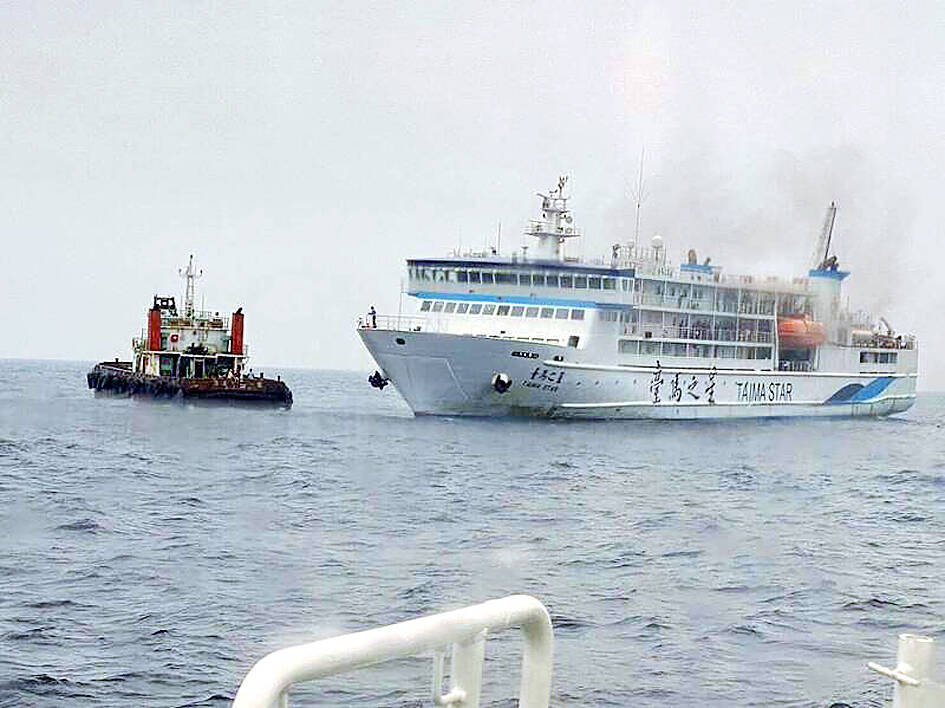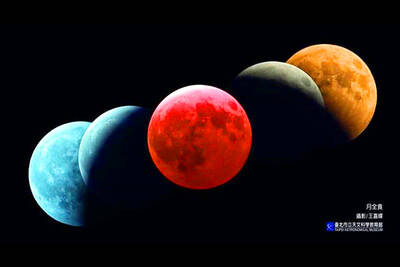A vessel ferrying passengers from Taiwan to the Matsu Islands drifted at sea for several hours yesterday because of power troubles, leaving 389 passengers stuck at sea, according to the Maritime and Port Bureau.
The bureau said in a statement that the Taima Star ferry left the Port of Keelung on Friday night at 10:15 pm on a routine voyage to the Matsu Islands and was scheduled to arrive at Fuao Harbor on the island of Nangan (南竿) at around 6 am yesterday.
Just after 4 am, however, the vessel, which had 389 passengers on board, experienced a loss of power while still on its way to Nangan.

Photo courtesy of Lienchiang County Government
According to the bureau, its maritime safety system discovered that something was wrong at 4:32 am when it noticed that the Taima Star’s speed had fallen unexpectedly about 53 kilometers away from Nangan Island.
After it contacted the ferry’s operator, the bureau learned that the ferry suddenly had problems supplying power to its engines. A push boat was later deployed from Baisha Harbor on Beigan Island at 10:30 am to tow the ferry to Fuao Harbor.
The push boat and Taima Star finally arrived at the destination just before 3 pm yesterday.
Upon arrival, Lienchiang County, which administers the Matsu Islands, gave the passengers food and NT$600 (US $19.56) in compensation.

Three batches of banana sauce imported from the Philippines were intercepted at the border after they were found to contain the banned industrial dye Orange G, the Food and Drug Administration (FDA) said yesterday. From today through Sept. 2 next year, all seasoning sauces from the Philippines are to be subject to the FDA’s strictest border inspection, meaning 100 percent testing for illegal dyes before entry is allowed, it said in a statement. Orange G is an industrial coloring agent that is not permitted for food use in Taiwan or internationally, said Cheng Wei-chih (鄭維智), head of the FDA’s Northern Center for

LOOKING NORTH: The base would enhance the military’s awareness of activities in the Bashi Channel, which China Coast Guard ships have been frequenting, an expert said The Philippine Navy on Thursday last week inaugurated a forward operating base in the country’s northern most province of Batanes, which at 185km from Taiwan would be strategically important in a military conflict in the Taiwan Strait. The Philippine Daily Inquirer quoted Northern Luzon Command Commander Lieutenant General Fernyl Buca as saying that the base in Mahatao would bolster the country’s northern defenses and response capabilities. The base is also a response to the “irregular presence this month of armed” of China Coast Guard vessels frequenting the Bashi Channel in the Luzon Strait just south of Taiwan, the paper reported, citing a

UNDER PRESSURE: The report cited numerous events that have happened this year to show increased coercion from China, such as military drills and legal threats The Chinese Communist Party (CCP) aims to reinforce its “one China” principle and the idea that Taiwan belongs to the People’s Republic of China by hosting celebratory events this year for the 80th anniversary of the end of World War II, the “retrocession” of Taiwan and the establishment of the UN, the Mainland Affairs Council (MAC) said in its latest report to the Legislative Yuan. Taking advantage of the significant anniversaries, Chinese officials are attempting to assert China’s sovereignty over Taiwan through interviews with international news media and cross-strait exchange events, the report said. Beijing intends to reinforce its “one China” principle

A total lunar eclipse, an astronomical event often referred to as a “blood moon,” would be visible to sky watchers in Taiwan starting just before midnight on Sunday night, the Taipei Astronomical Museum said. The phenomenon is also called “blood moon” due to the reddish-orange hue it takes on as the Earth passes directly between the sun and the moon, completely blocking direct sunlight from reaching the lunar surface. The only light is refracted by the Earth’s atmosphere, and its red wavelengths are bent toward the moon, illuminating it in a dramatic crimson light. Describing the event as the most important astronomical phenomenon